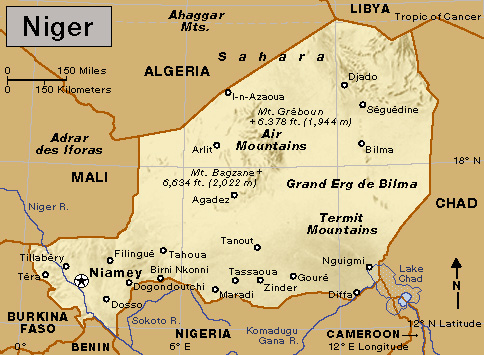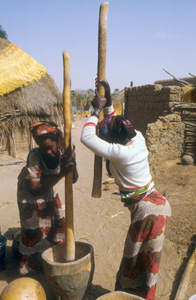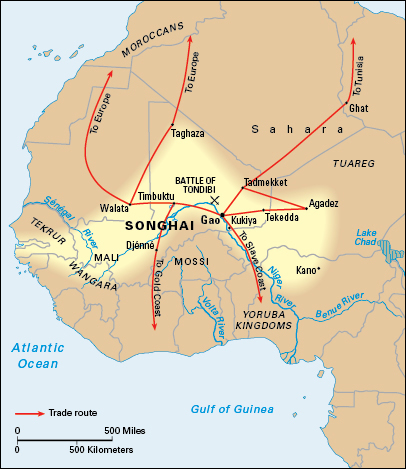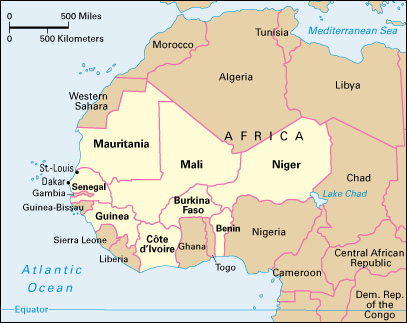Niger << NY juhr or nee ZHAIR >> is a large, landlocked country in west Africa. Barren desert and mountains cover most of northern Niger. A grassy, thinly wooded plain extends along the southern border. The country, officially called the Republic of Niger, takes its name from the Niger River, which flows through its southwest corner. Niamey is Niger’s capital and largest city.

The people of Niger belong to many different ethnic groups, each with its own language and customs. A large majority of the people are Muslims. Most people work as farmers and live in the south, where water and land are available.
Niger became an independent nation in 1960. France had ruled it for about 60 years before independence.
Government.
The president is the most powerful official in the government. The president appoints a prime minister and other members of the cabinet, determines their responsibilities, and may end their appointments at any time. The president is elected by the people to a five-year term.
The National Assembly is responsible for making Niger’s laws. The members of the National Assembly are elected to five-year terms. The Constitutional Court is Niger’s highest court in constitutional matters, and the Court of Cassation is the highest court in other matters.

People.
The people of Niger are called Nigeriens << nee ZHEH ree ehnz >> . The major ethnic groups in Niger include the Hausa, Djerma-Songhai, Tuareg, Fulani, and Kanuri.
The Hausa make up more than half of the population of Niger. They live mainly in the south and work as farmers. About one-fifth of the people are members of the Djerma-Songhai ethnic group. The Djerma-Songhai are farmers and live in the southwestern corner of the country, along the Niger River. The Kanuri make up about 5 percent of the population. They farm the rich land in southeast Niger.
Many of the Tuareg and the Fulani are nomadic (traveling) people who raise livestock for food. The Tuareg and the Fulani each make up about 10 percent of the population. During the rainy season, which lasts from July through September, these two groups live in the barren desert country of northern Niger. In dry months, they travel south in search of water and pastureland.
Most of the people who live in Niger’s rural areas raise crops and livestock for food and for export. Some Nigeriens who live near the Niger River or Lake Chad fish for a living. The nomadic groups raise camels, cattle, goats, and sheep. In the late 1960’s and early 1970’s, and again in the early 1980’s, severe droughts led to the deaths of many of the nomads’ animals. As a result, many nomads were forced to become farmers or move to urban areas.
Niamey, Niger’s capital, is its largest city by far. Other large cities include Agadez (Agades), Maradi, Tahoua, and Zinder. Most urban workers in Niger have jobs in the government and other services, or in business.
Houses in rural Niger are built according to the traditions of the ethnic groups. The Hausa live in crowded villages and towns, in houses built of sun-dried mud bricks. The nomadic Tuareg live in tents made of skins or mats. The nomadic Fulani build houses out of straw and branches, and must construct new homes every time they move. The Nigerien government has built low-cost single-family houses in Niamey. 
Nigeriens eat mainly grains and dairy products. Several popular dishes are made with millet and sorghum. The grains are often cooked into a porridge and served with a sauce. The nomadic Fulani and Tuareg live mainly on milk products from their herds. They also trade these products for grains and vegetables.
Loading the player...Nigerien folk music
Most Nigerien women wear long, wraparound skirts with short blouses and sandals. Men may wear pants or knee-length shorts with loose shirts or robes. Tuareg men wear turbans with veils. The Fulani and Tuareg, who travel in desert areas, wear long, loose robes for protection from the sun.
Education in Niger is free, but many areas do not have schools. The government operates the public schools. Many places have Qur’ānic schools, which teach Muslim religious knowledge. A system of “tent schools” serves the nomadic groups in the north. When a group moves, the school moves with it. Most of Niger’s adults cannot read or write.
French is the official language of Niger and is widely used in the schools. However, most Nigeriens commonly speak the language of their ethnic group, instead of French. More than 85 percent of the population understand the Hausa language, which serves as the language of trade. The language of the Djerma-Songhai is the second most widely spoken language. Some Nigeriens speak Arabic.
Most Nigeriens are Muslims. A small percentage of urban dwellers are Christians. Some rural Nigeriens practice traditional African religions.
The ethnic groups in Niger have produced many kinds of crafts, music, dance, and art. Craftworkers make gold and silver jewelry, pottery, leatherwork, cloth, and wood carvings. People in both urban and rural areas enjoy traditional African styles of music. Popular forms of recreation include cycling, basketball, and soccer.
Land and climate.
Sandy plateaus and desert cover the northern two-thirds of Niger. In the center of this region, a large area of mountain ranges called the Air Mountains rises above the flat landscape. These mountains include the highest peak in Niger, Mount Bagzane, which stands 6,634 feet (2,022 meters) above sea level. Less than 7 inches (17.5 centimeters) of rain falls each year in the mountains. The surrounding desert receives even less rain. Temperatures in the area can reach as high as 122 °F (50 °C).
Niger’s most productive zone for herding animals and growing crops is the savanna, a grassy, thinly wooded plain in the south. The savanna extends from the Niger River in the west, along Niger’s southern border, to Lake Chad in the east. It is one of the hottest places in the world, with average daily temperatures in Niamey reaching 95° to 100 °F (35° to 38 °C). Most of Niger’s rain falls in the savanna area. The city of Zinder receives about 22 inches (55 centimeters) annually.
Niger is a landlocked nation, with no outlet to the sea. The Niger River flows for about 350 miles (563 kilometers) across the southwest corner of Niger. The river floods each January and February and provides irrigation water for growing crops along its banks. Part of Lake Chad lies in southeastern Niger. 
Niger’s plant and animal life vary from north to south. Few plants grow in the desert, except near oases, where the date palm tree is common. Such wild animals as foxes, ostriches, barbary sheep, and gazelles and other antelope live in the north. Palm, mahogany, kapok, acacia, and baobab trees grow in the south. Wild animals in the south include elephants, warthogs, baboons, giraffes, and crocodiles.
Economy.
Niger is one of the poorest countries in the world. Only a small portion of its land is used to grow crops, and it has few natural resources. At various times, droughts have caused sharp reductions in crop and livestock production, devastating the economy.
Most of Niger’s people live by farming and herding. Agricultural products include beef and dairy cattle, camels, cowpeas, goats, millet, onions, peanuts, and sorghum. The country is a major producer of uranium. Coal, gold, petroleum, and salt are also mined.
Niger exports agricultural products and uranium. Leading imports include food, machinery, petroleum products, and vehicles. China, France, and Nigeria are among Niger’s chief trading partners.
Poor transportation has hampered economic development in Niger. Most of the country’s roads are not paved. Few Nigeriens own an automobile. Trucks carry freight, and people get around by buses or on foot. Niamey has an international airport. The country has both state-owned and privately owned radio and television stations.
History.
About A.D. 1000, Tuareg people began moving south from the middle of the Sahara into what is now Niger. They eventually controlled the trade routes across the desert and south to the coast. In the 1400’s, a Tuareg empire grew up around the city of Agadez. The Songhai Empire became powerful in the 1400’s. Its capital was Gao, in what is now Mali. During the 1500’s, the empire conquered the Tuareg at Agadez, and controlled much of central and western Niger. In 1591, an army from Morocco captured Gao, and the Songhai Empire collapsed. See Africa (The empires of west Africa).


European explorers first arrived in Niger during the early 1800’s. The French occupied parts of western Africa under agreements reached in 1885 and 1890 between the various European groups. France gained control of most of Niger by 1900. It put down a strong Tuareg resistance in 1906. Niger became part of the large French territory called French West Africa in 1922. Niger gained independence from France on Aug. 3, 1960.
Hamani Diori, the leader of the Niger Progressive Party (Parti Progressiste Nigérien, or PPN), was elected Niger’s first president. In the late 1960’s and early 1970’s, a severe drought struck Niger, causing widespread food shortages and other problems. In 1974, a group of army officers headed by Seyni Kountché overthrew Diori’s government. Kountché became president of the Supreme Council (formerly called the Supreme Military Council), which held all governing power. Kountché died in 1987, and the council chose Colonel Ali Saïbou to succeed him. Niger’s economy suffered during the 1980’s because worldwide prices of uranium declined.
In 1992, Niger adopted a multiparty political system. Mahamane Ousmane was elected president in 1993. In 1995, the government signed peace accords with Tuareg and Toubou groups who had been in rebellion since 1990.
In 1996, General Ibrahim Baré Maïnassara led a military coup—that is, a sudden take-over of the government. Maïnassara then won a presidential election, though opposition leaders claimed the election was fraudulent. Maïnassara was assassinated in 1999. Military leaders created a new constitution, which voters approved that same year. Mamadou Tandja, head of the National Movement for Society Development (Mouvement National pour la Société du Développement, or MNSD), was elected president. He was reelected in 2004.
In 2010, Tandja was overthrown in a military coup. The coup leaders established a junta called the Supreme Council for the Restoration of Democracy. A junta is a political group that holds power after a revolution. In 2011, democracy was reestablished in Niger, and former prime minister Mahamadou Issoufou was elected president. Issoufou was reelected in 2016.
In 2015, Boko Haram, an Islamist terrorist group based in neighboring Nigeria, attacked villages in Niger. Niger formed a military coalition with Benin, Cameroon, Chad, and Nigeria to fight Boko Haram. Other Islamist terrorist groups also began attacks on civilian and military targets through much of the Sahel region of west Africa, including Niger. In 2020, five countries together known as the G5—Burkina Faso, Chad, Mali, Mauritania, and Niger—formed a joint military force with France to combat the Islamist insurgents.
In 2021, Mohamed Bazoum, a former interior minister, was elected president and took office in the first peaceful transfer of power since 1960. However, Bazoum was overthrown in a military coup in 2023. The coup’s leaders claimed that the government had not done enough to stop terrorism in Niger.
